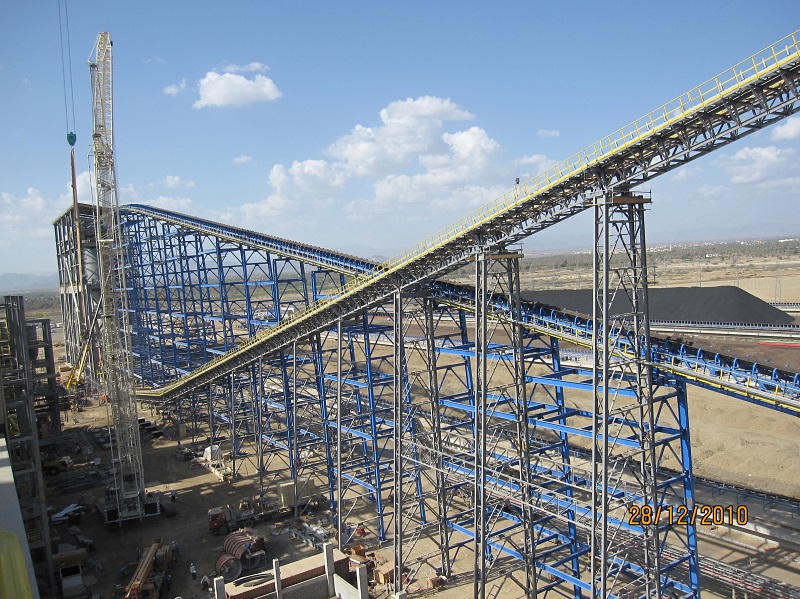Downwards Transportation Belt Conveyor: High-efficiency, energy-saving and safe choice
Downwards Transportation Belt Conveyor
With the continuous advancement of industrialization, logistics and transportation have become an indispensable part of modern society. In logistics and transportation, conveyors, as an efficient, energy-saving and safe logistics equipment, are widely used in various fields. Among them, the Downwards Transportation Belt Conveyor, as a special conveyor, has unique advantages and application scenarios.

1. Definition of Downwards Transportation Belt Conveyor
Downwards Transportation Belt Conveyor is a conveyor capable of conveying materials under conditions of large inclination angles. It adopts a special belt structure and conveying mechanism, which can still convey materials stably even when the inclination angle reaches 90 degrees. Therefore, Downwards Transportation Belt Conveyor is widely used in mining, port, electric power, chemical industry and other industries, and has become an indispensable logistics equipment in these industries.
2. Advantages of Downwards Transportation Belt Conveyor
1). High efficiency and energy saving
This Belt Conveyor adopts special conveying mechanism and belt structure, which can carry out material conveying under the condition of large inclination angle. Compared with traditional conveyors, Downwards Transportation Belt Conveyor can transport materials more efficiently, save energy and reduce operating costs.
2). Safe and reliable
Downwards Transportation Belt Conveyor adopts a special conveying mechanism and belt structure, which can stably transport materials under the condition of large inclination angle. At the same time, Downwards Transportation Belt Conveyor is also equipped with a variety of safety protection devices, such as power failure protection, overload protection, leakage protection, etc., which can effectively guarantee the safe operation of the equipment.
3). Strong adaptability
Downwards Transportation Belt Conveyor is suitable for various material transportation scenarios, such as mines, ports, electric power, chemical industry and other industries. At the same time, Downwards Transportation Belt Conveyor can also adapt to different material conveying requirements, such as conveying angle, conveying distance, conveying volume, etc.
3. Application scenarios of Downwards Transportation Belt Conveyor
1). Mining industry
In the mining industry, Downwards Transportation Belt Conveyor is widely used in material transportation in mines and ore lifting in mines. It can adapt to different material conveying requirements in the mine, such as conveying angle, conveying distance, conveying volume, etc., and can also improve the mine's material conveying efficiency and reduce operating costs.
2).Port industry
In the port industry, Downwards Transportation Belt Conveyor is widely used in port bulk cargo handling and container handling. It can adapt to different material conveying requirements in the port, such as conveying angle, conveying distance, conveying volume, etc., and can also improve the material conveying efficiency of the port and reduce operating costs.
3). Electric power industry
In the power industry, Downwards Transportation Belt Conveyor is widely used in coal transportation and ash transportation in power plants. It can adapt to different material conveying requirements in the power plant, such as conveying angle, conveying distance, conveying volume, etc., and can also improve the material conveying efficiency of the power plant and reduce operating costs.
4).Chemical Industry
In the chemical industry, Downwards Transportation Belt Conveyor is widely used in raw material transportation and finished product transportation in chemical plants. It can adapt to different material conveying requirements in chemical plants, such as conveying angle, conveying distance, conveying volume, etc., and can also improve the material conveying efficiency of chemical plants and reduce operating costs.
In a word, this Belt Conveyor, as an efficient, energy-saving and safe logistics equipment, is widely used in various fields. It can adapt to different material conveying requirements, and can also improve material conveying efficiency and reduce operating costs. Therefore, belt conveyor is an indispensable part of modern logistics transportation, and it is also an important direction for the development of logistics transportation in the future. If you also want to improve the efficiency of transporting materials, please contact JULI, a professional Belt Conveyor manufacturer.
 O'zbek
O'zbek slovenský
slovenský Azərbaycan
Azərbaycan Қазақ
Қазақ Latine
Latine ລາວ
ລາວ български
български नेपाली
नेपाली فارسی
فارسی Javanese
Javanese Українська
Українська Lietuvos
Lietuvos Română
Română Slovenski
Slovenski پښتو
پښتو Punjabi
Punjabi Bosanski
Bosanski Malti
Malti Galego
Galego Afrikaans
Afrikaans Esperanto
Esperanto 简体中文
简体中文 Српски
Српски मराठी
मराठी Ελληνικά
Ελληνικά čeština
čeština Polski
Polski ไทย
ไทย Nederlands
Nederlands Italiano
Italiano Tiếng Việt
Tiếng Việt Deutsch
Deutsch français
français русский
русский Português
Português Español
Español 한국어
한국어 Svenska
Svenska Malay
Malay اردو
اردو norsk
norsk Indonesia
Indonesia عربى
عربى Gaeilge
Gaeilge Türk
Türk Pilipino
Pilipino हिन्दी
हिन्दी Dansk
Dansk বাংলা
বাংলা English
English


Plane Turning Belt Conveyor Factory Advancing Efficient Material Handling Solutions
As global industries seek smarter and more efficient ways to move materials, the role of a reliable Plane Turning Belt Conveyor Factory has become increasingly important. Plane turning belt conveyors are designed to change the conveying direction smoothly on a horizontal plane, reducing transfer points and improving overall system efficiency. As a professional manufacturer in this field, JULI continues to set high standards in design, production, and customized conveyor solutions.
Read MoreHow Pipe Conveyor Systems Work: A Modern Solution for Enclosed Bulk Material Transport
Pipe conveyor systems are gaining increasing attention in industries that require efficient, clean, and flexible bulk material handling. As environmental regulations tighten and operational efficiency becomes a priority, understanding pipe conveyor working principles helps explain why this technology is being widely adopted in mining, cement, power generation, ports, and chemical processing.
Read MorePrecise Delivery of Key Spare Parts Ensures Stable Operation of Industrial Lifting Equipment
Recently, a batch of key mechanical spare parts for industrial lifting equipment, including guide rollers, clamping rollers, and gears, has completed production inspection and is ready to be shipped to an industrial site in Algeria.
Read More